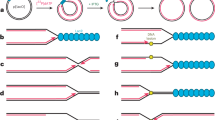Abstract
Polyoma middle-T antigen is required for viral transformation of cultured cells and for tumorigenesis in animals. Like many other transforming gene products, middle-T is bound to the membrane and has an associated tyrosine kinase activity in vitro1,2. This activity seems to result from the interaction of middle-T with pp60c-src, the cellular homologue of the transforming gene product of the Rous sarcoma virus, pp60v-src (refs 3–5). Both pp60v-src (ref. 6) and another retrovirus transforming gene product, pp68v-ros (ref. 7) were shown recently to have an associated phosphatidylinositol (PI) kinase activity in vitro and to increase PI turnover in vivo. These results suggest that viral transformation may be directly connected to a complex network of second messengers generated from PI turnover8–18. Here, we assayed for PI kinase activity in immunoprecipitates made with middle-T- or pp60c-src-specific antisera of cells infected with polyoma virus. A PI kinase activity was detected in those immunoprecipitates which contained middle-T. Studies of mutants of middle-T defective in transformation indicate a close correlation between PI kinase activity and transformation.
This is a preview of subscription content, access via your institution
Access options
Subscribe to this journal
Receive 51 print issues and online access
$199.00 per year
only $3.90 per issue
Buy this article
- Purchase on Springer Link
- Instant access to full article PDF
Prices may be subject to local taxes which are calculated during checkout
Similar content being viewed by others
References
Smith, A. E. & Ely, B. K. Adv. viral Oncol. 3, 3–87 (1983).
Schaffhausen, B. S. CRC Rev. Biochem. 13, 215–269 (1983).
Courtneidge, S. & Smith, A. E. Nature 303, 435–439 (1983).
Courtneidge, S., Oostra, B. K. & Smith, A. E. Cancer Cells Vol. 2, 123–132 (Cold Spring Harbor Laboratory, New York, 1984).
Sefton, B., Hunter, T., Beemon, K. & Eckhart, W. Cell 20, 807–816 (1980).
Sugimoto, Y., Whitman, M., Cantley, L. & Erikson, R. Proc. natn. Acad. Sci. U.S.A. 81, 2117–2121 (1984).
Macara, I. G., Marinetti, G. V. & Balduzzi, P. C. Proc. natn. Acad. Sci. U.S.A. 81, 2728–2732 (1984).
Berridge, M. Biochem. J. 220, 345–360 (1984).
Michell, R. Phil. Trans. R. Soc. B296, 123–137 (1981).
Penniston, J. T. Ann. N. Y. Acad. Sci. 402, 296–300 (1982).
Carafoli, E. & Zurini, M. Biochim. biophys. Acta 683, 279–301 (1982).
Smith, C. D. & Wells, W. W. J. biol. Chem. 259, 11890–11894 (1984).
Lipsky, J. J. & Lietman, P. S. Antimicrob. Ag. Chemother. 18, 532–535 (1980).
Nishizuka, Y. Nature 308, 693–698 (1984).
Whitman, M., Epstein, J. & Cantley, L. J. biol. Chem. 259 (in the press).
Streb, H., Irvine, R. F., Berridge, M. J. & Schulz, I. Nature 306, 67–69 (1983).
Joseph, S., Thomas, A. P., Williams, R. J., Irvine, R. F. & Williamson, J. R. J. biol. Chem. 259, 3077–3081 (1984).
Burgess, G. M. et al. Nature 309, 63–66 (1984).
Kaplan, D. R. et al. Molec. cell. Biol. (submitted).
Carmichael, G. G., Schaffhausen, B. S., Dorsky, D. I., Oliver, D. B. & Benjamin, T. L. Proc. natn. Acad. Sci. U.S.A. 79, 3579–3583 (1982).
Benjamin, T. L., Carmichael, G. G. & Schaffhausen, B. S. Cold Spring Harb. Symp. quant. Biol. 44, 263–273 (1980).
Oostra, B. A., Harvey, R., Ely, B. K., Markham, A. F. & Smith, A. E. Nature 304, 456–459 (1983).
Carmichael, G., Schaffhausen, B., Mandel, G., Liang, T. & Benjamin, T. Proc. natn. Acad. Sci. U.S.A. 81, 679–683 (1984).
Bolen, J. B. et al. Cell 38, 767–777 (1984).
Benjamin, T. L. Proc. natn. Acad. Sci. U.S.A. 73, 394–399 (1970).
Smith, C. C. & Wells, W. W. J. biol. Chem. 258, 9368–9373 (1983).
Seyfred, M. A. & Wells, W. W. J. biol. Chem. 259, 7659–7665 (1984).
Wilson, D. B., Bross, T. E., Hofmann, S. L. and Majerus, P. W. J. biol. Chem. 259, 11718–11724 (1984).
Feunteun, J., Sompayrac, L., Fluck, M. & Benjamin, T. Proc. natn. Acad. Sci. U.S.A. 73, 4169–4173 (1976).
Bendig, M., Thomas, T. & Folk, W. J. Virol. 33, 1215–1220 (1980).
Bockus, B., Roberts, T., Parsons, S. & Schaffhausen, B. Molec. cell. Biol. (submitted).
Courtneidge, S. & Smith, A. E. EMBO J. 3, 585–591 (1984).
Laemmli, U. K. Nature 227, 680–685 (1970).
Parsons, S. J., McCarley, D. J., Ely, C. M., Benjamin, D. C. & Parsons, J. T. J. Virol. 51, 272–282 (1984).
Author information
Authors and Affiliations
Rights and permissions
About this article
Cite this article
Whitman, M., Kaplan, D., Schaffhausen, B. et al. Association of phosphatidylinositol kinase activity with polyoma middle-T competent for transformation. Nature 315, 239–242 (1985). https://doi.org/10.1038/315239a0
Received:
Accepted:
Published:
Issue Date:
DOI: https://doi.org/10.1038/315239a0
This article is cited by
-
Mechanistic insights into the alterations and regulation of the AKT signaling pathway in diabetic retinopathy
Cell Death Discovery (2023)
-
MAPK4 promotes triple negative breast cancer growth and reduces tumor sensitivity to PI3K blockade
Nature Communications (2022)
-
At a crossroads: how to translate the roles of PI3K in oncogenic and metabolic signalling into improvements in cancer therapy
Nature Reviews Clinical Oncology (2022)
-
Insights from transgenic mouse models of PyMT-induced breast cancer: recapitulating human breast cancer progression in vivo
Oncogene (2021)
-
Cross-talk between non-coding RNAs and PI3K/AKT/mTOR pathway in colorectal cancer
Molecular Biology Reports (2021)
Comments
By submitting a comment you agree to abide by our Terms and Community Guidelines. If you find something abusive or that does not comply with our terms or guidelines please flag it as inappropriate.



